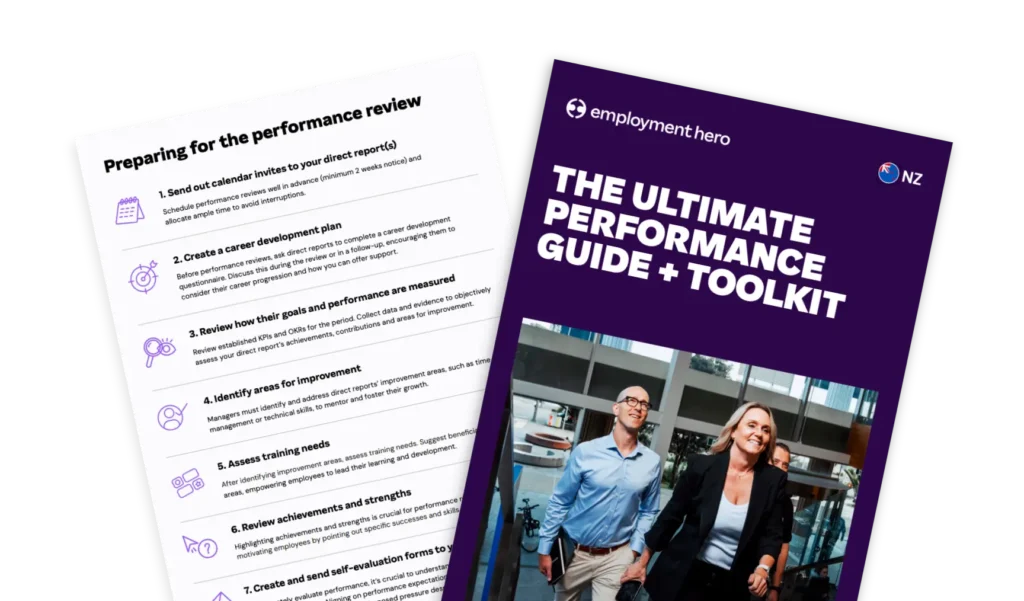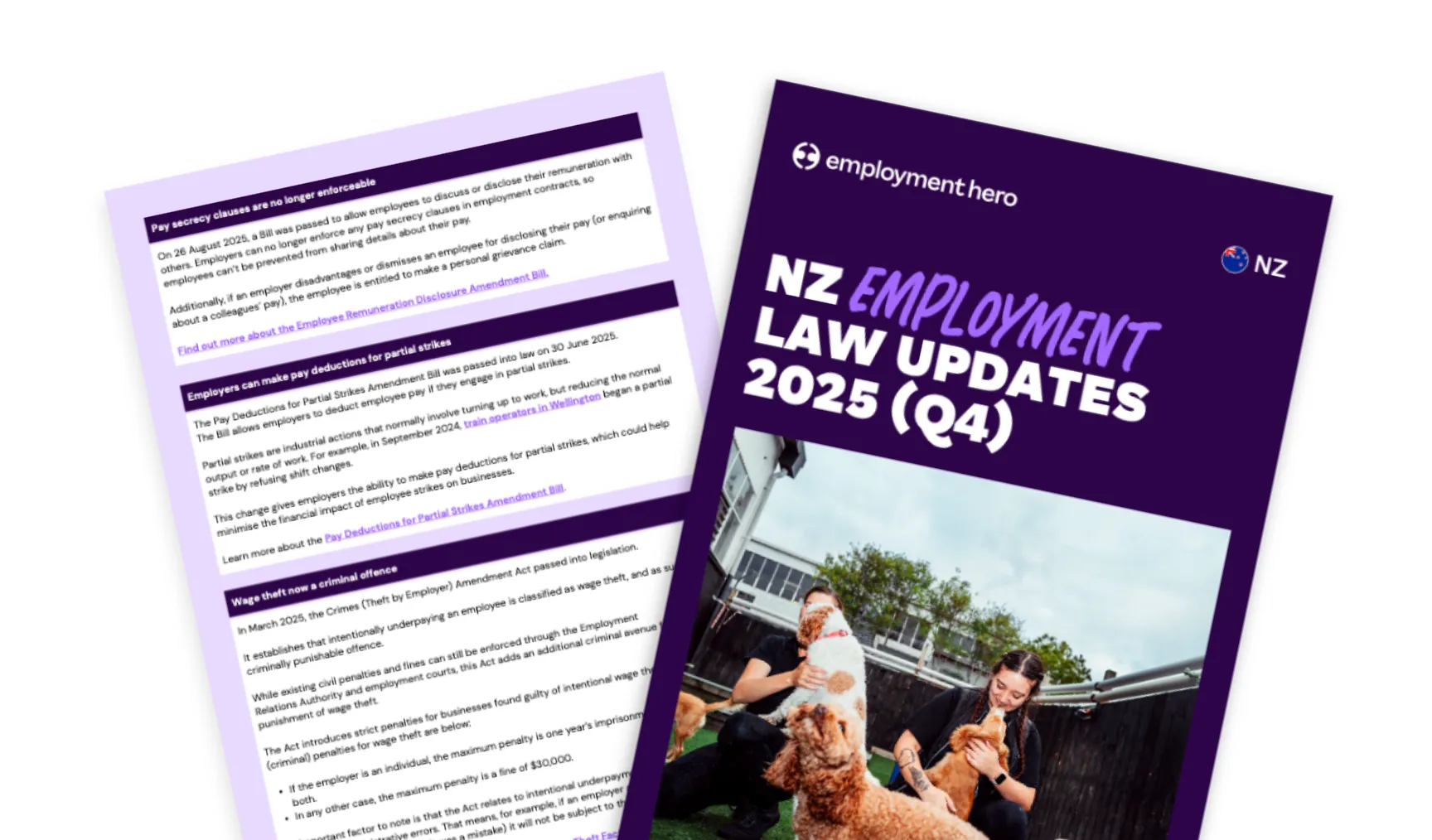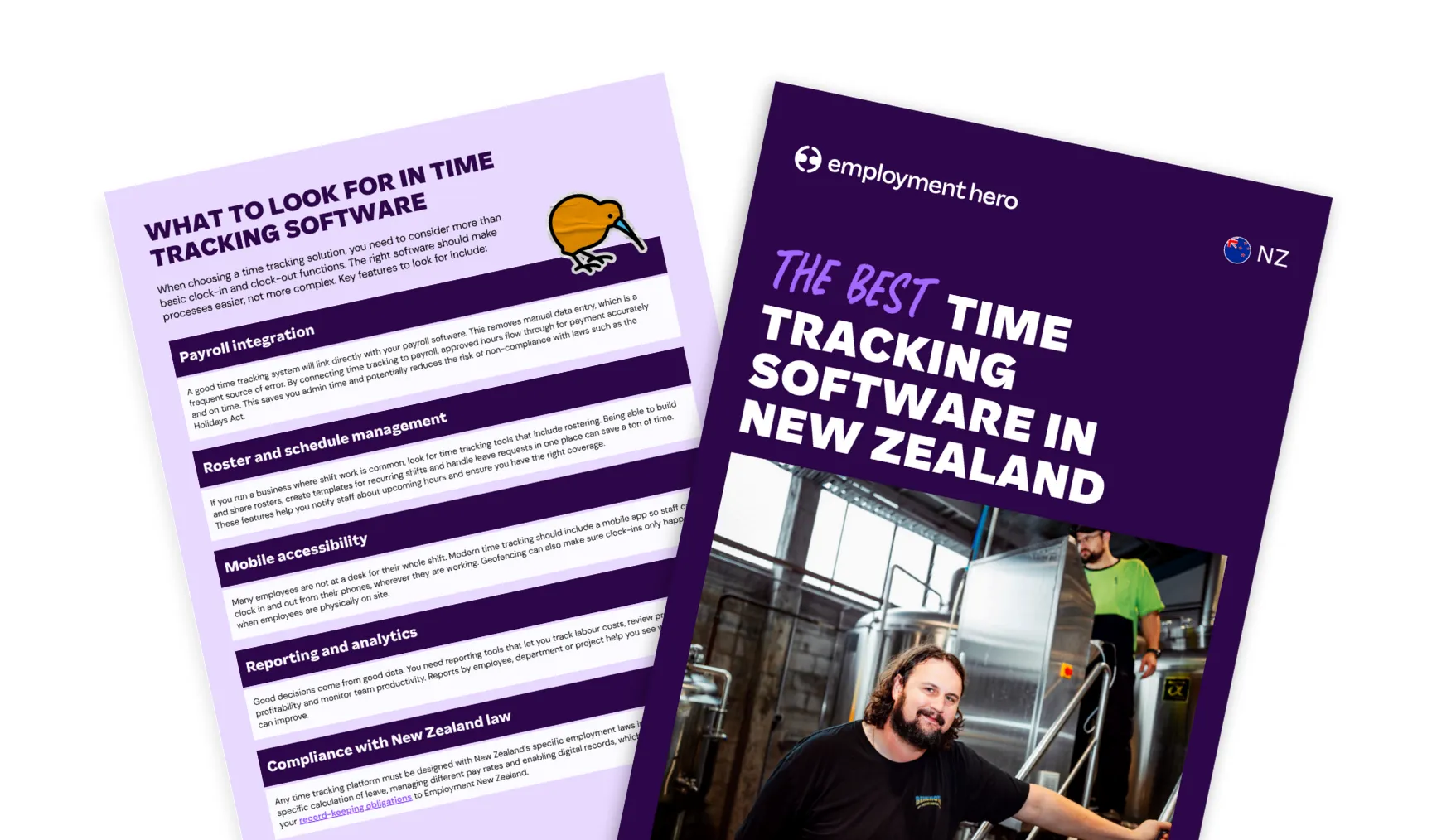Performance review guide: How to conduct effective reviews
Published
Performance review guide: How to conduct effective reviews
Get started on effective performance review planning today with our comprehensive guide and toolkit.

The annual performance review: a phrase that might cause unease for managers and employees alike. It’s a relic of a time when feedback was a once-a-year event, often filled with surprises and awkward silences. But here’s the thing: that old-school approach isn’t working for ambitious Small-to-Medium Enterprises (SMEs).
The modern workplace demands a culture of ongoing feedback and continuous development. Why? Because when your team knows exactly where they stand, what they’re doing well and where they can grow. They feel valued, motivated and empowered to reach their full potential.
This guide is your new playbook. We’re challenging the status quo and showing you a better, more valuable way to handle employee reviews—one that goes beyond compliance to drive engagement, boost productivity and power real growth for your business.
Get started today and download the guide using the form on the right.
What is a performance review?
A performance review is a scheduled meeting between an employee and their direct manager. It’s a formal, comprehensive assessment that evaluates the employee’s work over a defined period—typically quarterly or bi-annually—to define their strengths, identify opportunities for growth, review professional goals and plan for the future.
The ultimate goal of a performance review is professional improvement. It’s a collaborative experience, designed to support an employee’s growth journey and help them achieve more.
A review isn’t just a simple tick-box exercise. It’s an opportunity to discuss:
- Progress towards established objectives and Key Performance Indicators (KPIs) or Objectives and Key Results (OKRs).
- The effectiveness of the employee’s working style and soft skills, such as communication and time management.
- Attendance, punctuality and behaviour in the workplace.

Why do performance reviews matter to your business?
In New Zealand, while there isn’t a legal requirement to conduct formal performance reviews, they are a fundamental part of good-faith employment practice and effective people management. A clear performance criteria and feedback system helps both you and your employee have a shared, objective view of their progress against expectations.
Effective performance management is an invaluable tool for your business for a number of reasons:
- Boosts engagement and motivation: Regular, quality feedback ensures employees know their work is appreciated and how they’re contributing to the company’s mission.
- Drives development and growth: Reviews can identify training needs and skill gaps, ensuring you invest in the right areas to propel your workforce forward.
- Mitigates risk: Documented, regular performance discussions are vital for fairness and compliance, especially when addressing underperformance. In New Zealand, the Employment Relations Act 2000 mandates that employers must act in good faith, which includes giving an employee a genuine opportunity to improve their performance before taking further action.
- Informs reward and recognition: Performance data helps objectively link great work to salary reviews, bonuses or non-monetary rewards like time-off in lieu.
How to conduct a good performance review
A great performance review is built on preparation, collaboration and a focus on the future. We all know that there’s more to performance reviews than simply sitting down in a meeting with your direct report and chatting through the past year. For performance reviews to be as effective as possible, they require preparation from both parties. Whatever the frequency, you need to have a clear agenda in place so you both can get the most out of the session. If you walk in unprepared, you’ll set the wrong tone and give off the impression that you’re not invested in your team’s performance.

Download our guide for details and steps you need to take to ensure the best performance review process for your employees. Fill in the form on the right.
Looking to take performance reviews digital? Check out our performance management software and talk to a business specialist today.
How often should performance reviews be conducted?
When determining the cadence for your team’s performance reviews, there’s no single magic number; you need to find what works best for your organisation.
While annual reviews are common practice, it’s simply not enough for today’s fast-paced workplace. Employees are actively looking for more feedback. To find your sweet spot, consider:
- Are managers holding regular 1:1s (weekly or fortnightly) with their direct reports? This is crucial for a continuous feedback culture.
- Does your company culture genuinely embrace two-way, constructive feedback?
- Does your team want more frequent formal feedback?
No matter the cadence you choose, the key is to embrace continuous feedback and regular manager/employee catch-ups. This approach can dramatically improve communication, overall engagement and performance, ensuring that there are no nasty surprises when the formal review comes around.
Have you considered 360-degree reviews? These reviews bring in perspectives from across your business. Find out how you can facilitate 360 feedback through Employment Hero.
Are quarterly reviews better than annual reviews?
Yes, modern approaches are winning the game over the traditional, dreaded annual review. An annual review doesn’t provide real-time information, which can lead to lower morale and disengagement. Discussing a whole year’s worth of work in one go is tough, and hearing about a shortcoming for the first time in a formal review can be a real shock for an employee.
Real-time employee evaluations and frequent manager-employee check-ins are far more effective.
| Feature | Annual reviews | Quarterly reviews / Continuous feedback |
|---|---|---|
| Frequency | Once a year. | Quarterly, or ongoing through 1:1s. |
| Focus | Review of past performance (up to 12 months). | Forward-looking: goal-check-ins, coaching and immediate feedback. |
| Impact | Can be surprising or feel punitive; prone to ‘recency bias’. | Builds trust, encourages continuous improvement and ensures no surprises. |
| Admin | Huge amount of preparation and paperwork at once. | Lower administrative load when digitised and automated. |
Why give progressive feedback on employee performance?
Progressive (or continuous) feedback is about creating a coaching culture where feedback is expected, not feared. It’s a signal that you genuinely care enough to help your team do better.
Employees are more satisfied when they receive timely praise and guidance for their work. Without this regular communication, your team can become disengaged and lack the drive to succeed. Regular feedback is an essential tool for high-performing teams.
Key benefits of a continuous feedback culture include:
- Immediate correction and reinforcement: Address small issues before they become big problems and immediately reinforce positive behaviours.
- Builds trust: Feedback delivered with care says, “I see you and I believe in your potential.”
- Drives innovation: Create a safe environment where mistakes are reframed as learning opportunities (and not failures). This encourages calculated risk-taking and experimentation.
- Makes formal reviews easier: When you address performance gaps regularly, there are no surprises in the formal review, making the process objective and fair.
How do you create an effective performance review process?
An effective process is fair, transparent and collaborative, requiring preparation by both the manager and the employee. Our downloadable guide includes a full view of the process, or you can access our simple performance review checklist.
1. Planning and preparation. You wouldn’t walk into a client meeting unprepared, so don’t do it for your team.
- Schedule the review in advance
- Gather performance data and metrics
- Send a self-evaluation form to your employee
- Identify growth opportunities
2. Structure and delivery. The review should have a clear agenda, focusing on a holistic view of the employee’s performance and future goals.
- Start with their achievements and strengths
- Discuss the self-evaluation
- Incorporate 360-degree feedback
- Share the space and actively listen
- Provide actionable steps
3. Documentation. This is essential in New Zealand to demonstrate fair and reasonable process, especially when managing performance issues.
- Document what has been discussed
- Share the summary
- Schedule follow-up 1:1 meetings

How to provide feedback after performance reviews
Feedback, both positive and constructive, should be an ongoing dialogue, not just a post-review event. Remember the principle of good faith; feedback must be delivered with genuine care for the employee’s development.
Provide constructive feedback
The key to valuable feedback is being specific, actionable and focusing on the behaviour, not the person. The Situation-Behaviour-Impact (SBI) Model is a straightforward, powerful framework that cuts the noise.
| Element | Description | Ask Yourself… |
|---|---|---|
| Situation | Where and when the event occurred. | Where were we, and when did this happen? |
| Behaviour | The specific action the person took (without judgement). | What did they actually do or say? |
| Impact | The measurable effect of that behaviour on the team or business. | What was the consequence of this behaviour? |
Turn negative performance evaluations into actionable goals
If a performance review reveals significant shortcomings, the path is clear: support and a transparent roadmap for improvement.
- Clarity is kindness: Don’t ‘sandwich’ bad news between vague compliments; be honest but kind. The employee needs to fully grasp what the performance gaps are.
- Focus on the ‘how’: Transform a weakness (e.g. “poor time management”) into a clear, measurable SMART goal and an action plan. Outline the support you’ll provide, such as additional training or resources.
- Communicate consequences: In cases of formal underperformance, you must clearly advise the employee of the expected outcomes if the performance benchmarks are or are not met.
How should managers handle negative feedback during reviews?
Negative feedback can trigger a defensive response. In New Zealand, managers must adhere to good-faith principles, especially when dealing with underperformance.
1. Stay objective and calm. Focus on the documented behaviour and its impact (SBI model). Avoid generalisations like “You always…” or judging character instead of behaviour.
2. Active listening. Let the employee express their perspective and concerns without interruption. Ask clarifying questions like, “Can you give me an example of why you think that happened?”
3. Offer a support person. While it’s not strictly required in a non-disciplinary review, if the conversation involves underperformance, an employee can ask for details ahead of time and may ask to bring a support person. It is generally good practice to allow this.
4. Don’t raise surprises. Never bring up old, unaddressed issues or things not previously discussed in regular catch-ups. This can be seen as unfair or a breach of good faith.
5. Be prepared for a Performance Improvement Plan (PIP). If the underperformance is significant and informal coaching hasn’t worked, you must have a formal, structured process ready to go.
The goal is to open a line of communication, set clear expectations and give the employee a genuine opportunity to succeed.
Should performance reviews be used for promotions or salary raises?
Yes, linking the formal performance review to the salary review is a common and recommended practice in New Zealand. There are several advantages and considerations for this.
Advantages:
- Fair reward: It ensures that salary adjustments (increases or bonuses) are objectively based on documented performance, contributions to the organisation and the employee’s achievements.
- Motivation: It clearly links good performance to tangible rewards, reinforcing positive behaviour.
- Clarity: It provides a clear, documented process for allocating rewards.
Considerations:
- Distraction from development: If the review is solely about the pay cheque, the development conversation can get lost.
- The ‘no-raise’ problem: If you decide against a pay rise, make sure you respond in good faith, providing a clear justification based on the performance criteria. If a pay rise isn’t viable, consider non-monetary rewards like a time-off in lieu or gift vouchers.
Best practice: Separate the development conversation from the salary discussion, even if they happen around the same time of year. Focus the performance review meeting on growth and then have a separate, shorter meeting to communicate the formal salary decision.
Download the ultimate performance guide and toolkit
Ready to ditch the dread and build a truly high-performing team?
Our Ultimate Performance Guide and Toolkit is packed with templates, frameworks and best-practice advice to transform your approach to performance management.
What’s inside:
- Self-evaluation performance review template.
- Professional development plan template.
- 1:1 meeting template.
- Performance Improvement Plan (PIP) template.
- In-depth guidance on 360-degree feedback, giving valuable feedback and more.
Download your copy now and start making employment easier and more valuable for everyone.
Types of performance reviews

Beyond the format and frequency, there are different models you can use to gather a more comprehensive picture of an employee’s work and measure performance.
Traditional annual reviews vs modern approaches
As we’ve discussed, traditional reviews are a formal, once-a-year evaluation, often focusing on past shortcomings. Modern approaches prioritise agility and continuous development. They are forward-looking, involving regular 1:1s, coaching and real-time feedback, ensuring a continuous feedback loop.
360-degree feedback reviews
In a traditional review, feedback is only top-down, i.e. from the manager. A 360-degree review gathers a more rounded view of an employee’s professional development by compiling insights from numerous sources: the manager, direct reports, peers, clients and customers.
Peer-to-peer performance reviews
This is a form of 360-degree feedback where co-workers assess each other. Peers often have the best insights into an employee’s daily contributions, collaboration skills and how well they embody the company’s core values.
Self-assessment reviews
The self-evaluation is a crucial component of the modern review process. It asks employees to rate their own performance, achievements and contributions. When compared with the manager’s review, it helps align expectations and bridge any perceived gaps in performance.
Project-based performance evaluations
These are focused reviews conducted at the end of a major project or assignment. They help to identify successes and areas for improvement or training that can help facilitate a better process next time.
Probationary period reviews
These are necessary check-ins during the first few months of employment. They are designed to ensure the new hire is settling in, meeting initial expectations and identifying any urgent training needs early on.
Preparing for performance reviews
Preparation is the secret weapon of an effective performance review and will make a huge difference for your employee if they can see you’re taking this as seriously as they are. Here are some key preparation steps to consider:
Gathering performance data and metrics
Start by collecting objective evidence, instead of relying on anecdotal memories. Review KPIs, OKRs, recorded employee achievements, notes from 1:1s and customer or team feedback. For formal underperformance, ensure your data is specific, measurable and links clearly to the employee’s role.
Setting clear review objectives
Both manager and employee should know the purpose of the meeting beforehand. Make sure any calendar invites contain detail on what the expectations are for the meeting and any preparation that needs to happen beforehand.
Reviewing employee performance records
A digital employee record (made easy with employee management platforms) allows managers to log feedback and achievements year-round, centralising all necessary data. This prevents “recency bias,” where a recent mistake overshadows an otherwise strong year.
Scheduling and logistics planning
Block out ample, uninterrupted time in a private meeting space. Rushing sends the message that you’re not invested. For remote teams, ensure you’re using a dedicated video meeting room and have a strong connection. Ask the employee to make sure they’re free from distractions and not in a busy coffee shop.
Preparing review documentation
This includes the formal review notes, the self-evaluation form and a template for the next development plan. Having a digital system in place eliminates lost paperwork and provides easy access to completed data for powerful reporting.
Training managers for effective reviews
People-management skills are vital. Your managers need to be trained on:
- The organisation’s performance policies and fair process steps.
- How to give effective, constructive feedback (e.g. the SBI Model).
- How to handle conflict and provide support, not just criticism.
Download the guide using the form on the right to make sure you’re prepared.
Performance review framework and structure
To remove subjectivity and make the process fair, you need a strong framework to measure and guide performance.

Setting SMART performance goals
Setting goals should be a joint process between employee and employer. As an employer you’ll want to prioritise any goals that help to improve your business, but there needs to be a balance of ensuring they also support employee career goals. SMART goals should be specific, measurable, achievable, relevant and time-bound. They help the employee know exactly what’s expected of them and make the review of their achievement objective.
Key performance indicators (KPIs) selection
KPIs are the measurable metrics that indicate how effectively an employee is meeting business objectives. They should be quantifiable and directly relevant to the individual’s job description.
Competency-based assessment models
These models assess the underlying behaviours, knowledge and skills required for a role, not just the results.
| Example competency | Assessment criteria |
|---|---|
| Communication | Actively listens, articulates ideas clearly, and presents information succinctly. |
| Problem Solving | Identifies root causes of issues and develops creative, effective solutions. |
Behavioural assessment criteria
This involves reviewing how the employee acts in the workplace.
Consider: Do they consistently demonstrate professional behaviour, punctuality and a positive attitude?
Behaviours can set the tone for their team, as well as whether they are suitable for promotions to leadership positions where these behaviours have greater potential influence.
Cultural fit and values alignment
Cultural fit and values alignment can be essential to determining whether someone is right for your business in the long term. If they’re actively adding to your culture in a positive way, then this has potential for great impact on other employees.
Consider: Do your employees demonstrate the core values of your organisation? Assessing alignment shows an investment in a strong, positive team culture.
Performance rating scales and systems
Using a consistent rating scale (e.g. 1-5 stars) provides a clear benchmark for evaluation, comparing performance against set standards. It is important to define what each rating means to ensure objectivity.
Download the performance review guide
In the modern world of work, performance reviews are no longer a dreaded annual chore; they’re an engine for growth and engagement. By embracing continuous feedback, modern frameworks and digital solutions, New Zealand SMEs can transform their performance management process from an administrative burden into a strategic advantage.
Employment Hero is here to be your trusted partner on this journey, taking the administrative burden off your plate so you can focus on growing your business. Our Employment Operating System (Employment OS) includes tools like 1:1s, performance reviews, employee feedback and 360-degree reviews, making it simple to embrace a culture of continuous feedback.
Take the first step towards a high-performing team, download the full guide via the form on the right. Or if you’re looking for a platform solution to managing your employees and performance reviews, talk to one of our business specialists today.
To download the guide, we just need a few quick details:
Related Resources
-
 Read more: Employment law updates 2025/26
Read more: Employment law updates 2025/26Employment law updates 2025/26
Keep your business up-to-date with the latest changes in NZ employment law. Here’s what you need to know about the…
-
 Read more: Best time tracking software for NZ businesses
Read more: Best time tracking software for NZ businessesBest time tracking software for NZ businesses
Discover the best time tracking software for NZ businesses. Compare tools, find the right fit, and make time tracking simple…
-
 Read more: HR Managers: Don’t just survive the festive season, master it
Read more: HR Managers: Don’t just survive the festive season, master itHR Managers: Don’t just survive the festive season, master it
Make year-end easier: manage leave, payroll, parties and shutdowns with confidence. Get practical tips for NZ SMEs. Download the free…





















